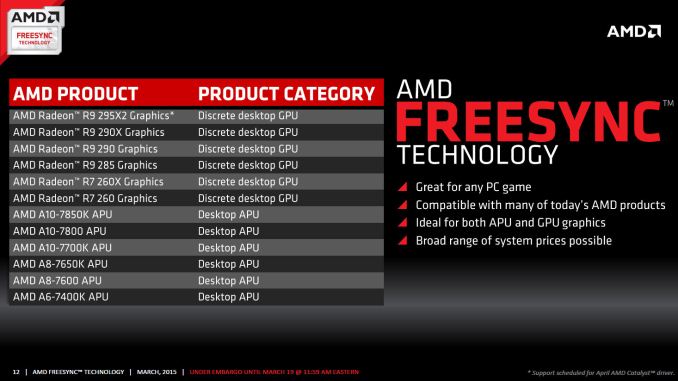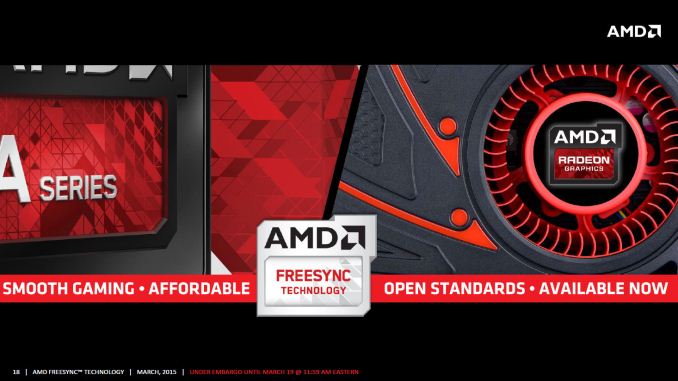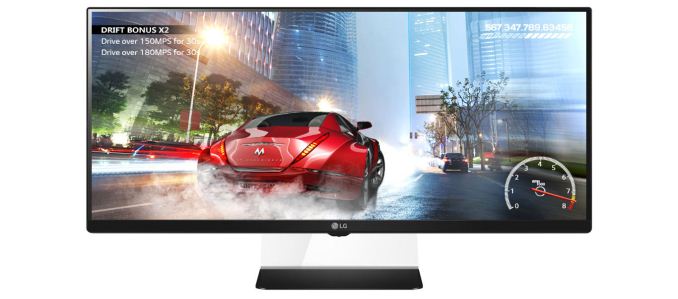The AMD FreeSync Review
by Jarred Walton on March 19, 2015 12:00 PM ESTClosing Thoughts
It took a while to get here, but if the proof is in the eating of the pudding, FreeSync tastes just as good as G-SYNC when it comes to adaptive refresh rates. Within the supported refresh rate range, I found nothing to complain about. Perhaps more importantly, while you’re not getting a “free” monitor upgrade, the current prices of the FreeSync displays are very close to what you’d pay for an equivalent display that doesn’t have adaptive sync. That’s great news, and with the major scaler manufacturers on board with adaptive sync the price disparity should only shrink over time.
The short summary is that FreeSync works just as you’d expect, and at least in our limited testing so far there have been no problems. Which isn’t to say that FreeSync will work with every possible AMD setup right now. As noted last month, the initial FreeSync driver that AMD provided (Catalyst 15.3 Beta 1) only allows FreeSync to work with single GPU configurations. Another driver should be coming next month that will support FreeSync with CrossFire setups.
Besides needing a driver and FreeSync display, you also need a GPU that uses AMD’s GCN 1.1 or later architecture. The list at present consists of the R7 260/260X, R9 285, R9 290/290X/295X2 discrete GPUs, as well as the Kaveri APUs – A6-7400K, A8-7600/7650K, and A10-7700K/7800/7850K. First generation GCN 1.0 cards (HD 7950/7970 or R9 280/280X and similar) are not supported.
All is not sunshine and roses, however. Part of the problem with reviewing something like FreeSync is that we're inherently tied to the hardware we receive, in this case the LG 34UM67 display. Armed with an R9 290X and running at the native resolution, the vast majority of games will run at 48FPS or above even at maximum detail settings, though of course there are exceptions. This means they look and feel smooth. But what happens with more demanding games or with lower performance GPUs? If you're running without VSYNC, you'd get tearing below 48FPS, while with VSYNC you'd get stuttering.
Neither is ideal, but how much this impacts your experience will depend on the game and individual. G-SYNC handles dropping below the minimum FPS more gracefully than FreeSync, though if you're routinely falling below the minimum FreeSync refresh rate we'd argue that you should lower the settings. Mostly what you get with FreeSync/G-SYNC is the ability to have smooth gaming at 40-60 FPS and not just 60+ FPS.
Other sites are reporting ghosting on FreeSync displays, but that's not inherent to the technology. Rather, it's a display specific problem (just as the amount of ghosting on normal LCDs is display specific). Using higher quality panels and hardware designed to reduce/eliminate ghosting is the solution. The FreeSync displays so far appear to not have the same level of anti-ghosting as the currently available G-SYNC panels, which is unfortunate if true. (Note that we've only looked at the LG 34UM67, so we can't report on all the FreeSync displays.) Again, ghosting shouldn't be a FreeSync issue so much as a panel/scaler/firmware problem, so we'll hold off on further commentary until we get to the monitor reviews.
One final topic to address is something that has become more noticeable to me over the past few months. While G-SYNC/FreeSync can make a big difference when frame rates are in the 40~75 FPS range, as you go beyond that point the benefits are a lot less clear. Take the 144Hz ASUS ROG Swift as an example. Even with G-SYNC disabled, the 144Hz refresh rate makes tearing rather difficult to spot, at least in my experience. Considering pixel response times for LCDs are not instantaneous and combine that with the way our human eyes and brain process the world and for all the hype I still think having high refresh rates with VSYNC disabled gets you 98% of the way to the goal of smooth gaming with no noticeable visual artifacts (at least for those of us without superhuman eyesight).
Overall, I’m impressed with what AMD has delivered so far with FreeSync. AMD gamers in particular will want to keep an eye on the new and upcoming FreeSync displays. They may not be the “must have” upgrade right now, but if you’re in the market and the price premium is less than $50, why not get FreeSync? On the other hand, for NVIDIA users things just got more complicated. Assuming you haven’t already jumped on the G-SYNC train, there’s now this question of whether or not NVIDIA will support non-G-SYNC displays that implement DisplayPort’s Adaptive Sync technology. I have little doubt that NVIDIA can support FreeSync panels, but whether they will support them is far less certain. Given the current price premium on G-SYNC displays, it’s probably a good time to sit back and wait a few months to see how things develop.
There is one G-SYNC display that I’m still waiting to see, however: Acer’s 27” 1440p144 IPS (AHVA) XB270HU. It was teased at CES and it could very well be the holy grail of displays. It’s scheduled to launch next month, and official pricing is $799 (with some pre-orders now online at higher prices). We might see a FreeSync variant of the XB270HU as well in the coming months, if not from Acer than likely from some other manufacturer. For those that work with images and movies as well as playing games, IPS/AHVA displays with G-SYNC or FreeSync support are definitely needed.
Wrapping up, if you haven’t upgraded your display in a while, now is a good time to take stock of the various options. IPS and other wide viewing angle displays have come down quite a bit in pricing, and there are overclockable 27” and 30” IPS displays that don’t cost much at all. Unfortunately, if you want a guaranteed high refresh rate, there’s a good chance you’re going to have to settle for TN. The new UltraWide LG displays with 75Hz IPS panels at least deliver a moderate improvement though, and they now come with FreeSync as an added bonus.
Considering a good display can last 5+ years, making a larger investment isn’t a bad idea, but by the same token rushing into a new display isn’t advisable either as you don't want to end up stuck with a "lemon" or a dead technology. Take some time, read the reviews, and then find the display that you will be happy to use for the next half decade. At least by then we should have a better idea of which display technologies will stick around.













350 Comments
View All Comments
lordken - Thursday, March 19, 2015 - link
are you sure? they only have to come with different name (if they want). Just as both amd/nvidia calls and use "DisplayPort" as DisplayPort , they didnt have came up with their own implementations of it as DP is standardized by VESA so they used that.Or I am missing your point what you wanted to say.
Question is if it become core/regular part of lets say DP1.4 onwards as just now it is only optional aka 1.2a and not even in DP1.3 - if I understand that correctly.
iniudan - Thursday, March 19, 2015 - link
Well the implementation need to be in their driver, they not gonna give that to Nvidia. =pchizow - Thursday, March 19, 2015 - link
So it is also closed/proprietary on an open spec? Gotcha, so I guess Nvidia should just keep supporting their own proprietary solution. Makes sense to me.ddarko - Thursday, March 19, 2015 - link
You know repeating a falsehood 100 times doesn't make it true, right?chizow - Tuesday, March 24, 2015 - link
You mean like repeating FreeSync can be made backward compatible with existing monitors with just a firmware flash, essentially for Free? I can't remember how many times that nonsense was tossed about in the 15 months it took before FreeSync monitors finally materialized.Btw, it is looking more and more like FreeSync is a proprietary implementation based on an open-spec just as I stated. FreeSync has recently been trademarked by AMD so there's not even a guarantee AMD would allow Nvidia to enable their own version of Adaptive-Sync on FreeSync (TM) branded monitors.
ddarko - Thursday, March 19, 2015 - link
From the PC Perspective article you've been parroting around like gospel all day today:"That leads us to AMD’s claims that FreeSync doesn’t require proprietary hardware, and clearly that is a fair and accurate benefit of FreeSync today. Displays that support FreeSync can use one of a number of certified scalars that support the DisplayPort AdaptiveSync standard. The VESA DP 1.2a+ AdaptiveSync feature is indeed an open standard, available to anyone that works with VESA while G-Sync is only offered to those monitor vendors that choose to work with NVIDIA and purchase the G-Sync modules mentioned above."
http://www.pcper.com/reviews/Displays/AMD-FreeSync...
That's the difference between an open and closed standard, as you well know but are trying to obscure with FUD.
chizow - Friday, March 20, 2015 - link
@ddarko, it says a lot that you quote the article but omit the actually relevant portion:"Let’s address the licensing fee first. I have it from people that I definitely trust that NVIDIA is not charging a licensing fee to monitor vendors that integrate G-Sync technology into monitors. What they do charge is a price for the G-Sync module, a piece of hardware that replaces the scalar that would normally be present in a modern PC display. It might be a matter of semantics to some, but a licensing fee is not being charged, as instead the vendor is paying a fee in the range of $40-60 for the module that handles the G-Sync logic."
And more on that G-Sync module AMD claims isn't necessary (but we in turn have found out a lot of what AMD said about G-Sync turned out to be BS even in relation to their own FreeSync solution):
"But in a situation where the refresh rate can literally be ANY rate, as we get with VRR displays, the LCD will very often be in these non-tuned refresh rates. NVIDIA claims its G-Sync module is tuned for each display to prevent ghosting by change the amount of voltage going to pixels at different refresh rates, allowing pixels to untwist and retwist at different rates."
In summary, AMD's own proprietary spec just isn't as good as Nvidia's.
Crunchy005 - Friday, March 20, 2015 - link
AMDs spec is not proprietary so stop lying. Also I love how you just quoted in context what you quoted out of context in an earlier comment. The only argument you have against freeSync is ghosting and as many people have pointed out is that it is not an inherent issue with free sync but the monitors themselves. The example given in that shows three different displays that all are affected differently. The LG and benq both show ghosting differently but use the same freeSync standard so something else is different here and not freeSync. On top of that the LG is $100 less than the asus and the benQ $150 less for the same features and more inputs. I don't see how a better more well rounded monitor that can offer variable refresh rates with more features that is cheaper is a bad thing. From the consumer side of things that is great! A few ghosting issues that i'm sure are hardly noticeable to the average user is not a major issue. The videos shown there are taken at a high frame rate and slowed down, then put into a compressed format and thrown on youtube in what is a very jerky hard to see video, great example for your only argument. If the tech industry could actually move away from proprietary/patented technology, and maybe try to actually offer better products and not "good enough" products that force customers into choosing and being locked into one thing we could be a lot father along.chizow - Friday, March 20, 2015 - link
Huh? How do you know Nvidia can use FreeSync? I am pretty sure AMD has said Nvidia can't use FreeSync, if they decide to use something with DP 1.2a Adaptive Sync they have to call it something else and create their own implementation, so clearly it is not an Open Standard as some claim.And how is it not an issue inherent with FreeSync? Simple test that any site like AT that actually wants answers can do:
1) Run these monitors with Vsync On.
2) Run these monitors with Vsync Off.
3) Run these monitors with FreeSync On.
Post results. If these panels only exhibit ghosting in 3), then obviously it is an issue caused by FreeSync. Especially when we have these same panel makers (the 27" 1440p BenQ is apparently the same AU optronics panel as the ROG Swift) have panels on the market, both non-FreeSync and G-Sync) that have no such ghosting.
And again you mention the BenQ vs. the Asus, well guess what? Same panel, VERY different results. Maybe its that G-Sync module doing its magic, and that it actually justifies its price. Maybe that G-Sync module isn't bogus as AMD claimed and it is actually the Titan X of monitor scalers and is worth every penny it costs over AMD FreeSync if it is successful at preventing the kind of ghosting we see on AMD panels, while allowing VRR to go as low as 1FPS.
Just a thought!
Crunchy005 - Monday, March 23, 2015 - link
Same panel different scalers. AMD just uses the standard built into the display port, the scaler handles the rest there so it isn't necessarily freeSync but the variable refresh rate technology in scaler that would be causing the ghosting. So again not AMD but the manufacturer."If these panels only exhibit ghosting in 3), then obviously it is an issue caused by FreeSync"
Haven't seen this and you haven't shown us either.
"Maybe its that G-Sync module doing its magic"
This is the scaler so the scaler, not made by AMD, that supports the VRR standard that AMD uses is what is controlling that panel not freeSync itself. Hence an issue outside of AMDs control. Stop lying and saying it is an issue with AMD. Nvidia fanboys lying, gotta keep them on the straight and narrow.